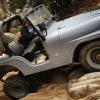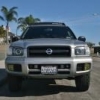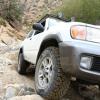Not trying to hijack the thread, but this seems like a good place for this article on exhausts.............
"There is a common misconception that engines need backpressure in order to run properly, generate low end torque, etc. That is simply untrue. Backpressure is a bad thing. Always. Take a look at a top fuel dragster...how much backpressure do you think those zoomie headers make? Very little, and those engines produce 6500 hp. So, what is backpressure? Any fluid flowing through a pipe experiences drag on the walls of the pipe. This depends on a number of factors, including the diameter of the pipe, the smoothness of the inside of the pipe, the viscosity of the fluid, and the velocity of the fluid. This drag results in a pressure drop through the pipe. In order for the fluid to flow at all, the pressure on one end of the pipe must be higher than at the other. In an exhaust system, that pressure drop is what we refer to as backpressure. It's pretty obvious that the engine has to produce this pressure differential, so the less power it has to spend making pressure to push the exhaust out, the more power it can send to the wheels. Given that exhaust pipes are pretty smooth, and that we can't change the viscosity (thickness) of the waste gas being forced through the pipes, we are left with basically 2 parameters we can have any control over: The pipe diameter and the gas velocity. Unfortunately, the pipe diameter controls the gas velocity since the volume of gas is prescribed by the engine. So, we really only have one thing we can change. So, bigger pipes allow less pressure drop for a given volume of gas because the velocity is lower. The pressure drop (backpressure increase) is proportional the gas velocity squared, so if I double the gas velocity (by reducing the cross sectional area of the exhaust pipe by half) then I quadruple the pressure drop. Well, there's an easy solution for that: Just make the exhaust pipe bigger. Bigger pipe, lower gas velocity, less pressure drop, so less backpressure. Wow, that was easy. After all, this is the way it's done for basically any type of commercial plumbing system. Need less pressure drop on a chilled water pipe or a natural gas line? Just make the pipe bigger. But wait, there's a problem....Having a huge exhaust pipe has killed my low end torque!!! What's different? Oh, there's no backpressure!! Therefore backpressure makes torque! Wrong. An exhaust system is different than just about any other plumbing situation. How? Because the flow is pulsed, and this turns out to be a big deal. Every time a pulse of exhaust gas runs through the pipe, a strange thing happens: it as it passes, it has a little area of vacuum behind it. Just like a NASCAR stocker running around the track, the pulse generates a little bit of a vacuum behind it. In NASCAR, a driver can take advantage of another driver's vacuum by getting right behind him and driving in it. The wind resistance is drastically reduced. This is called drafting. Well, how big the vacuum behind each pules is depends on the gas velocity. The higher the velocity, the bigger the vacuum the pulse has behind it. Now, this means that I can "draft" the next pulse, just like in NASCAR. In NASCAR, it's called drafting, in an exhaust system, it's called scavenging. You've probably seen this term used when talking about headers, but the same concept applies in the pipe. I get the maximum scavenging effect if the gas velocity is high, so the pipe needs to be small. By maximizing the scavenging effect, I help to pull pulses out of the combustion chamber, which means the engine doesn't have to work as hard to do that. This has the most effect when there's a bunch of time between pulses...in other words, at low rpm. As the revs rise, the pulsed flow becomes more and more like constant flow, and the scavenging effect is diminished. So, at low rpm I need a small pipe to maximize scavenging, and at high rpm I need a big pipe to minimize pressure drop. My exhaust pipe can only be one size, so it's a compromise. For a given engine, one pipe diameter will make the most overall power (i.e., have the largest area under the curve on a dyno chart). So, the loss of torque has nothing to do with backpressure, and everything to do with gas velocity. So you need exhaust components that are not restricive (manifolds/headers, mufflers) and that are sized correctly for your application. To further dispel the "backpressure is necessary" theory, try this if you want. If you have access to a vehicle with open headers, make a block off plate that will bolt to the collector. This plate should have only a 1" hole in it for the exhaust to flow through. That will give you PLENTY of backpressure, and zero scavenging. Then you can report back on how much low end power it has. The one exception to sizing an exhaust is for turbo cars. Since the turbo is in the exhaust stream, the gas flow spinning the impeller tends to come out of the turbo with the pulses greatly diminished. In this case, you can get away with running a larger pipe than on an equivalent HP N/A engine because you can't take as much advantage of the scavenging effect."
Courtesy; J Branne, DSMTuners.com










